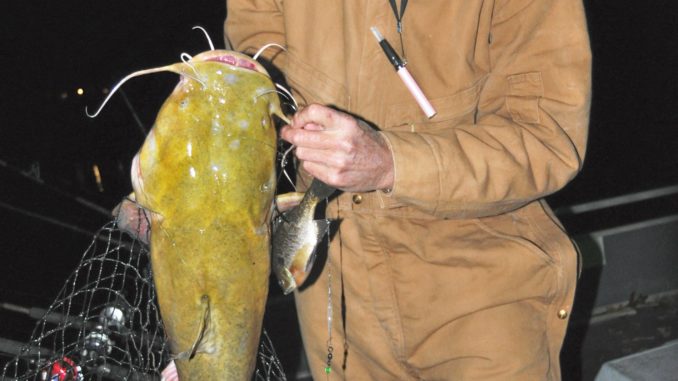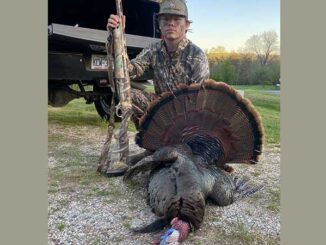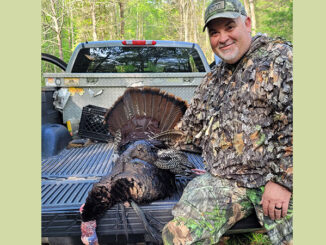
Looking for world-class catfish? There’s no better place to be than Kerr Lake during the winter if you’re hunting for the biggest of the big.
When winter arrives in North Carolina, only a few freshwater species remain consistently active enough for fishermen to target.
Largemouth bass basically shut down; the cold water temperatures having lowered their metabolisms. Stripers feed sporadically, but usually are scattered at large lakes. Crappie head to deepwater haunts and can be difficult to find.
But catfish are different, especially voracious Arkansas blues and flatheads. They continue to cruise the state’s big impoundments, looking for meals.
So for anglers wanting to catch a magnum-size fish during the cold months, blues and flatheads are prime targets.
And no lake in the state offers a better chance for a close encounter with a monster Mr. Whiskers than John H. Kerr Reservoir, a sprawling impoundment of the Dan and Roanoke (Staunton) rivers. Straddling the North Carolina-Virginia border at 49,500 acres, Kerr Lake, aka Buggs Island Lake, offers the chance to catch tackle-straining catfish whose sizes eclipse other freshwater targets.
Keith Wall of Buffalo Junction, Va., never passes up a good weather day in January to fish for Kerr’s giant blues and flatheads.
“I’m aiming at catching a 100-pounder or having one of my clients land one that big,” said the 41-year-old Wall, who makes his living as a tree trimmer. “Everybody by now knows Buggs Island’s got 100-pound catfish swimming in it.”
During the past 10 years, Kerr Lake anglers have landed several 80- and 90-pound blue cats and at least two 100-pounders, including the pending world record.
In March 2011, a 109-pound blue catfish was caught in the Virginia portion of the lake that became that state’s record for the species. Three months later, Nick Anderson of Greenville, N.C., landed a world-record, 143-pound blue catfish well up the lake near the confluence of the rivers — also Virginia “turf.”
Wall has hopes he can tie into one of these monsters.
“I’ve been fishing the lake for catfish, bass, crappie and stripers since I was 15 years old,” he said. “I gave up bass fishing several years ago, but I’ll still fish for crappie and stripers, along with catfish.
“Sometimes when we go catfishing, the stripers will come up (on the surface) and surprise everybody, and we’ll pick up a rod and throw topwater lures. That’s about the only time I don’t catfish.”
But Wall will only switch to stripers if he encounters them before he sets up for catfish. If he’s already soaking baits for big blues and flatheads, Wall gives stripers a pass.
“I know about eight spots that are good, big-catfish places,” Wall said. “Most of them are north of Clarksville (Va.).”
Wall’s catfishing technique is basically sedentary. He’ll choose a spot because he’s caught fish there in the past, anchor, bait his hooks and cast them out. Then, he begins a waiting game.
Wall is very specific about the underwater conditions needed to produce good bites, and that’s where he drops anchor.
“I’m looking for humps off the main river channel,” he said. “You can find them around the lake, but this place is particularly good to me.”
Underwater structure that Wall knows will hold catfish always harbors baitfish. Kerr Lake’s forage base includes threadfin and gizzard shad, although the lake now has a sizeable population of blueback herring, but herring are an open-water species and cruise constantly, making them difficult targets for catfish. Stripers and largemouths mainly chase herring, not catfish.
Wall, as does nearly every serious Buggs Island catfish hunter, knows anglers land the largest catfish starting about 1 1/2 miles upstream from Clarksville, west to the confluence of the Dan and Staunton Rivers, a distance of about five miles.
For him, a couple of places near the mouth of Bluestone Creek have been especially productive.
“A lot of large blues and channel cats have been caught here by me and other guys,” Wall said. “I think (catfish) may like it because of baitfish coming out of Bluestone Creek.”
What apparently makes this spot so appealing to catfish is its underwater configuration.
Think of the river channel as three sections of long PVC pipe cut in half lengthwise then placed side by side so one edge of each outer pipe touches one of the edges of the middle pipe. These edges would form the “humps” where Wall likes to anchor. The piece of pipe in the center (the river channel) is the deepest and is probably 300 yards from either shoreline near Bluestone Creek. However, as the channel rises on each side, it forms a hump, then it deepens again before rising again to both shorelines.
“I try to position the boat on one of the humps, then I’ll fan cast my baits on either side of the hump,” Wall said. “That’s where the baitfish are, the sides of those humps, and it’s why catfish hang out there.”
Wall said he discovered the absolute best habitat for catfish in this part of the lake occurs where rocky points extend from the shore to intersect with a hump on either side of the river.
“Rocks hold baitfish,” Wall said. “If you can find baitfish, you’ll find catfish. I’ll fan cast my baits into water that’s 20 feet deep, then 15, then 12 feet.”
Wall is particular when setting up his 20-foot pontoon boat.
“I found out I needed the extra room for catfishing,” he said in explanation for the large boat. “I have a 16-foot bass boat, but there’s not enough room when you’ve got a catfishing party — too many rods and reels and people moving around. The pontoon’s also a more-comfortable ride and a better place to wait out catfish.”
With the Dan River flowing basically east to west near Bluestone Creek, Wall drops heavy anchors at either end of his boat to hold it in a north-to-south position, directly above the crown of a hump.
“I don’t like much wind because, even with the boat anchored, wind makes it swing back and forth and puts slack in your lines,” he said. “You have to keep lines tight so you can see a catfish, especially a flathead, messing with your baits.
“If the boat’s swinging and you’re keeping tight lines, pretty soon you’ll find out your baits are about under the boat.”
Where he fishes, Wall said the best wind is from the north because it comes from the stern of the boat, not across its sides.
Flathead catfish are finicky eaters; they rarely take a bait and run with it. Blue cats are just the opposite.
“When a blue cat hits, your rod usually will just bend over, and he’ll just go and be on,” Wall said. “All you have to do is engage the reel and set the hook hard.
“But a flathead bite is different. A flathead will mess with baits. He’ll pick one up, mouth it, spit it out, swim off, then come back and play with it some more.”
Obviously, a rod tip that’s being bounced by a wary flathead causes trouble for novice anglers.
“Just remember, a blue’s going to hit a bait and take off with it, hard,” Wall said. “But if your rod tip is bouncing, leave it alone. If a flathead shows interest in a bait, he may pick it up in his mouth, then spit it out. Then he might swim around and come back to it again.
“The big mistake that people make with flatheads is they jerk the rod when they see the tip bounce once.”
Wall said he’s often ready to pick up his rods and try another location, only to find when he starts to reel in a bait on a particular rod, a flathead will be tugging at the hook.
“They really have a light touch at times,” he said. “The other day I had a guy fishing with me, and we started to move, and a 38-pound flathead was on his rod. The fish probably picked up the bait and swam toward the boat, so we never knew he was there. But sometimes, not often, a flathead will slam a bait just a like a blue cat. You actually don’t ever know what they’ll do.”
Wall said hard-charging attacks of baits by flatheads usually occur in spring and summer.
“During cold weather, flatheads usually are slow biters,” he said. “But blues, no; they’ll slam a bait any time of the year and go with it.”
The best water temperatures at Kerr Lake for flathead catfishing are above 50 degrees.
“When the water temperature drops below 50 degrees, you’re better off staying home and staying warm if you’re after flatheads,” Wall said. “For blue cats, the temperature doesn’t matter; they’ll bite any time of the year.”
Wall said winter catfish anglers don’t necessarily need to fish from a boat. Shoreline fishing is popular at Kerr Lake because the U.S. Army Corps of Engineers usually allows the lake level to drop each winter. Sometimes as much as 100 yards of shoreline will be exposed, and fishermen can soak baits for catfish by fan casting from the shore, using live or cut bait. They’ll often remain all night if the bite is hot, building fires while sitting in lawn chairs and watching their rods.
“The best bite for catfish at Buggs Island, any time of year, is right at dusk, and it’ll continue on through the night,” Wall said. “If you’re coming to catfish, be ready for some night fishing.”
But anglers also may do everything right and still strike out.
“A fellow I know was fishing from the bank (across from Staunton River Park) and caught 300 pounds of catfish,” Wall said. “But he said the only thing they’d hit was cut pieces of carp. One day they may only hit shad, bream another time, or crappie another time. Now it’s carp, if you believe that. I do know they’re finicky at times.”
More often, Wall said, catfish action is sporadic.
“You might fish for a few hours without even a nibble, then everything breaks loose,” Wall said. “You’re at the same place, with the same baits, and won’t get a bite, then all of a sudden, rods will start going off.”
Wall tries to keep noise at a low level in his boat, “but I don’t think noise scares catfish,” he said. “Me and a friend caught 15 in an hour or so one evening, and we were making all kinds of noise, trying to land fish, using the landing net, banging the sides of the boat. At times, he’d have a fish on, I’d have a fish on, and we’d have one hooked up to a rod in a holder. There was all kinds of noise, and it didn’t make a bit of difference to the catfish.”
January catfish anglers — whether on land or in a boat — should be sure to dress warmly, including head gear or parkas, insulated pants, jackets and shoes. A pair of gloves also comes in handy. On sunny days when the sun drops behind the horizon, air temperatures usually fall quick and can reach the 30s in a short while.
“One good thing about winter catfishing at Buggs Island; when you get a big one on, you forget about the cold,” Wall said.
DESTINATION INFORMATION
HOW TO GET THERE/WHEN TO GO — I-85 is the key that unlocks Kerr Lake to fishermen. Take NC 15 north from Oxford to fish the upper end of the lake near Clarksville, Va. The lower end of the lake is accessible from NC 39 and NC 4 out of Henderson. The best months for big blue catfish are December through February.
BEST BAITS/TACKLE — Live bream, crappie, shad or cut bait from the same three species plus catfish belly strips and carp strips are all good baits for catfish. All except shad must be caught with rod-and-reel to be legally used as bait. Shad can be caught in a cast net. Medium-stiff 7-foot rods with baitcasting reels spooled with 30-pound mono are typical catfish outfits. Use 18 inches of 80-pound braid for a leader, a No. 10/0 Kahle hook and a 2-ounce flat, triangular shaped weight.
FISHING INFO/GUIDES — Keith Wall, Wall’s Big Cat Guide Service, 434-738-5994, http://www.kerrlake.com/bigcatfish/; Rose Gin Bait & Tackle, Henderson, 252-438-5656. See also Guides & Charters in Classifieds.
ACCOMMODATIONS — For the Henderson area, contact Vance County Tourism Department, Henderson, 866-438-4565 or http://www.kerrlake-nc.com/kerrlake.cfm. For the Clarksville, Va. area, the hub of mid-lake fishing, try the Best Western-On the Lake, 434-374-5023 or www.bestwesternvirginia.com, or the Lake Motel & Efficiencies, 434-374-8106 or www.conradusa.com. The U.S. Army Corps of Engineers operates campgrounds scattered around the lake’s shoreline; 434-738-6827 or www.saw.usace.army.mil/jhkerr/index.htm; John H. Kerr Dam/Reservoir Visitors Assistance Center, 434-738-6101.
MAPS — GMCO 888-420-6277, www.gmcomaps.com; FHS Maps, 800-ALL-MAPS; U.S. Army Corps of Engineers, Boydton, Va., 434-738-143.









